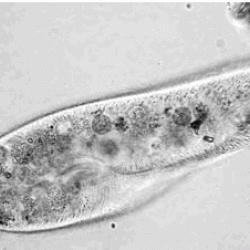Source Institutions
Source Institutions
Add to list Go to activity
Activity link broken? See if it's at the internet archive

In this activity, learners use a microscope to examine three different microbes: bacteria, yeast and paramecia. Educator will need to prepare the yeast solution one day before the activity. This lesson guide includes background information, educator resources and Slide Preparation Cards. A yogurt recipe is included as an extension to this activity.
- 10 to 30 minutes
- 45 to 60 minutes
- $5 - $10 per group of students
- Ages 8 - 14
- Activity, Experiment/Lab Activity, Lesson/Lesson Plan
- English
Quick Guide
Materials List (per group of students)
- Paramecia (order a culture in advance, collect pond water or make your own)
- 250-mL container (for yeast mixture)
- 150-mL of warm water (for yeast mixture)
- Package of dry baker's yeast (for yeast mixture)
- Teaspoon of sugar (for yeast mixture)
- 6-8 oz. of plain, unflavored yogurt
- 6 sheets of cardstock (to make Slide Preparation cards)
- Small dropper bottle of glycerin (one drop per slide will slow paramecia if they are overly active)
- Permanent markers to label droppers
- Microscope (one or more per group)
- 20 mL of tap water in a cup
- 3 plastic cover slips
- 3 plastic slides
- 3 droppers (one each for yeast mixture, pond water or paramecia, and tap water)
- Toothpick (for yogurt)
- Plastic tray (to hold materials)
- Set of colored pencils or markers
- Slide Preparation cards
- Science notebooks
- Group concept map (ongoing, if available)
Subjects
-
Engineering and Technology
-
Technology
- Agriculture and Biotechnology
-
Technology
-
Life Sciences
-
Cells
- Cell Structure and Function
-
Diversity of Life
- Viruses and Bacteria
- Protists and Fungi
- Classification
- Ecology
-
Cells
-
Mathematics
-
Data Analysis and Probability
- Data Analysis
- Data Collection
- Data Representation
-
Data Analysis and Probability
-
The Nature of Science
-
The Scientific Process
- Conducting Investigations
- Gathering Data
- Formulating Explanations
- Communicating Results
-
The Scientific Process
Informal Categories
- Food and Cooking
- Nature and Environment
Audience
To use this activity, learners need to:
- see
- read
- touch
Learning styles supported:
- Involves teamwork and communication skills
- Involves hands-on or lab activities
Other
Components that are part of this resource:
Includes alignment to state and/or national standards:
Includes assesments for student learning:
- What Do You Know About Microbes? (pre-assessment)
- And Now, What Do You Know About Microbes? (post-assessment)
This resource is part of:
Access Rights:
- Free access
By:
- Moreno, Nancy P. ; Tharp, Barbara Z. ; Erdmann, Deanne B. ; Clayton, Sonia Rahmati ; Denk, James P.
Rights:
- All rights reserved, Baylor College of Medicine, 2008
Funding Source:
- Science Education Partnership Award, 5R25 RR018605
